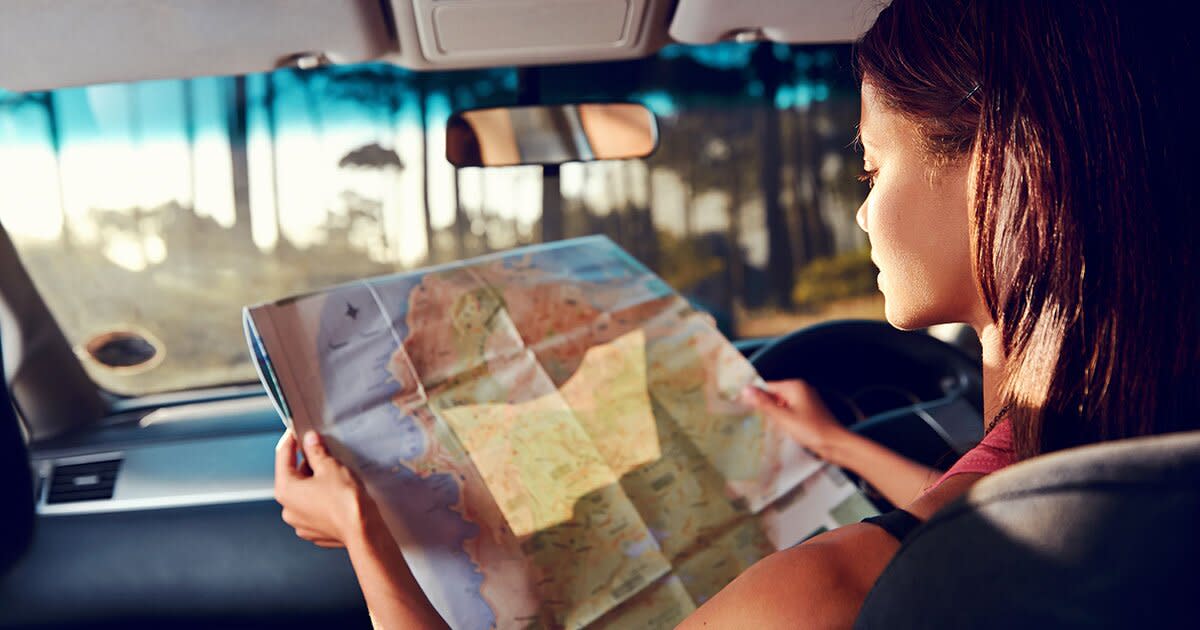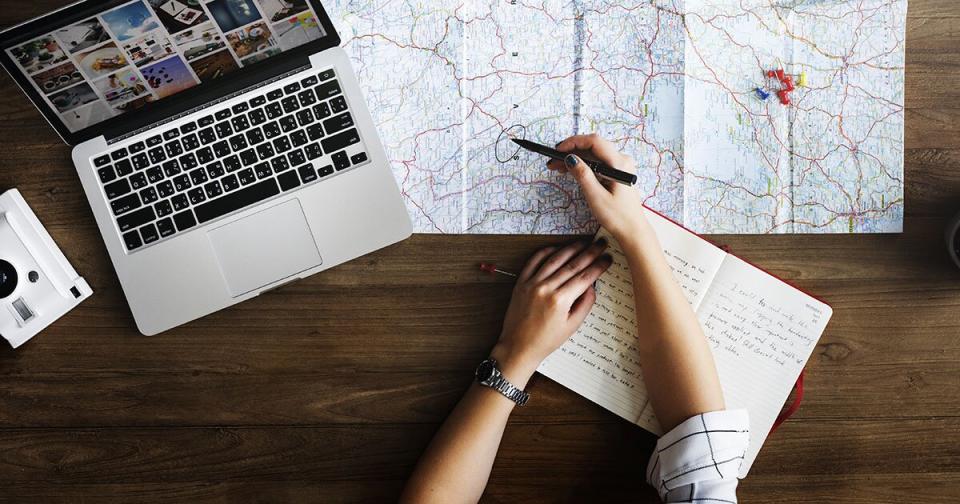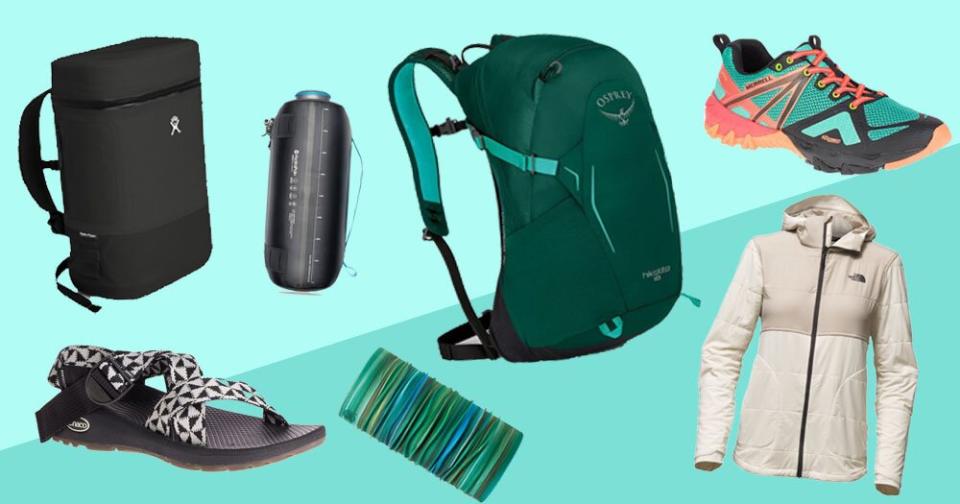How to Plan Your Own Outdoor Adventure Road Trip

Photo: Daxiao Productions/Shutterstock
If your idea of the perfect getaway includes seeing new breathtaking sights around the U.S. while hiking, trail running, biking, kayaking and more, get ready to meet your next vacation. There's no better way to cover some ground than turning it into a road trip, complete with a few activities in every nature-filled escape.
You can easily design your trip to the adventures you enjoy most, plus hit the best places in the country to do so. To help you plan it out, we turned to a few experts in the outdoor space who offer insight into making it a fun, action-packed (and stress-free!) trip. Here's your step-by-step guide to discovering cool new spots while sneaking in some exercise.
Step 1. Pick your activities.
Choose your can't-miss adventures. If your heart is set on biking, hiking, and kayaking, plan your pit-stops around those workouts. "We're ambitious humans these days, hoping to achieve it all, but in the end its best to prioritize a few activities that are dearest to the top of your wish list, rather than trying to accomplish everything in one trip," says Holly Mandarich, explorer for The Outbound Collective and the Pursuit Series. It's a good idea to make sure everyone you're traveling with is on the same page, too. (If you're up for a single-location epic challenge vs. a whole road trip, check out this guide to planning an adventure trip.)
Step 2. Consider hiring a guide.
If you're traveling to an area for the first time, guides can easily show you the best spots for your must-do activities and will likely have equipment for you to use. (Not everyone can fit a kayak or mountain bike in the car or in the overhead bin in an airplane, after all.) "Hikes are generally pretty straightforward and easy to complete unguided, but anything that requires specialized gear should be done with a guide," says Sonja Saxe, @thenationalparksgirl and another Outbound Collective explorer. Saxe says she typically Googles local guides, makes a list, checks reviews, and then goes with whoever has the best reputation.

Photo: Rawpixel.com/Shutterstock
Step 3. Scour the web.
Skipping guides and going full event-planner mode? The Internet is obviously your BFF for this, and you'll find some solid suggestions. Backcountry gearhead Sarah Savala recommends TrailForks.com for finding mountain biking paths and AllTrails.com for pinpointing scenic hiking routes. "They give you in-depth insight on trails and real-time updates from users that are out on the trails," she says. Of course, The Outbound and TripAdvisor will help as well.
Step 4. Get to know locals.
To really get some insider info on the area, talk up local baristas, your neighbor at lunch, the cashier at a nearby store, or head to the town's visitor center. You might find that the neighborhood has awesome rock climbing for beginners (and guides to get you there) or a gorgeous lake to go stand-up paddleboarding. Chatting up the people from the area means you might find an unexpected new favorite activity-which is why it's best to keep a loose itinerary for the trip, with room for change. "The truly best piece of advice I can give is to keep in mind that things don't always go as planned, stay open to the idea of a detour or unexpected adventure," says Mandarich. (See: Why You Should Try a New Adventure Sport Even If It Scares You.)
Step 5. Pack light and right.
Just like a camping trip, don't go overboard on the items you bring-especially clothing. (Here's a complete guide to packing light for vacation.) "I think people tend to overdo it when it comes to packing clothes, at least I know I did when I first started road tripping," says Saxe. "I re-wear clothes more than once and mix and match outfits to save extra space." (You can take advantage of laundromats if you're going for multiple days.) She also recommends keeping the car organized, so you don't have to worry about rummaging around to find that one top or sports bra.
Besides the usual travel essentials, you'll want to pack a few general items for the road: any equipment you want for your activities, fresh fruit and veggies, portable snacks (such as bars and jerky), an audiobook or good playlist for the drive, and a notebook to jot down your best adventures. As for more specific items, here are some expert-recommend gear for smoother travels:

Portable cooler: Hydroflask Unbound Series Soft Cooler Pack
Stash your produce, food, water bottles, and beer or wine in this cooler. The leakproof, insulated container works as a backpack so you can easily transport it on a hike or to the water. ($275,
Water storage: HydraPak Expedition 8L
Stay hydrated for days by picking up this water dispenser, which comes with an easy-pour spout and flexible handle for simple carrying. Once empty, it rolls flat so you can pack it away when you need to. ($60, hydrapak.com)
Durable daypack: Osprey Hikelite 18
Take only your essentials out for a day hike, trail run, or ride with this light-yet-durable pack that'll fit all your necessities. It has a ventilated back panel so you don't overheat, plus a rain cover in case the weather turns wet. ($85, amazon.com)
Hybrid sneakers: Merrell Women's MQM Flex Gore-Tex
This durable shoe works for roads or trails and hikes or runs, thanks to its lightweight construction, waterproof top layer, breathable mesh lining, air-cushioned heel, and extra traction underfoot. ($140, zappos.com)
Sturdy sandals: Chaco Women's Mega Z Cloud
Give your feet some fresh air, while still having enough support to take a short hike or walk along the water in these durable sandals. ($115, zappos.com)
Extra layer: The North Face Mountain Sweatshirt
It's always a good idea to pack a warmer outer layer, just in case temps drop-and this one is so buttery soft, you'll want to wear it all day and night. ($149, thenorthface.com)
Cool headwrap: BUFF UV Insect Shield
Keep bugs and sunburn away with this headwrap that doubles as a scarf-perfect for whatever time of year you're traveling. ($28, amazon.com)

Photo: Grand Prismatic Spring in Yellowstone National Park / Edward Fielding/Shutterstock
Step 6. Book your adventure!
Whether you're going to camp out or book a hotel (or go glamping!), make sure you have everything mapped out for where and how far you'll drive each day (a paper map might come in handy!. All the experts said a maximum of five hours of driving a day is a good limit, so you can maximize your time outside. Three hours is even better.
Here, a few sweet spots across the country to consider for a four- or five-day road trip:
Montana to Wyoming: Head to Pray, MT (not far from Bozeman airport) for trail running, then make your way to Yellowstone National Park for a day of hiking and geyser viewing. Next, check out the beautiful red mountains at Slide Lake, where you can kayak, before making your way to Grand Teton National Park (one of the 10 National Parks to Visit Before You Die) for more hiking, trailing running, or biking.
Michigan's Upper Peninsula: Bike, hike, or kayak in the Porcupine Mountains Wilderness State Park, a 60,000-acre park filled with lakes, rivers, and streams. (Also a great place to visit for winter sports.) Then, head east to Pictured Rocks National Lakeshore, where you'll spot awesome views of Lake Superior. Stop here to swim, boat, hike, and bike. (See: 7 Michigan Parks to Visit for Outdoor Adventures.)
Shenandoah National Park to Great Smoky Mountains National Park: Your East Coast adventure: Travel from Virginia to North Carolina (a total of about five and a half hours). In Virginia's Shenandoah National Park, you have 500 miles of trails to hike (more than 100 of those on the Appalachian Trail) or opt to bike along Skyline Drive. In the Smoky Mountains (well-known for its waterfalls) you can hike, trail run, fish, bike or even go horseback riding. (Read this story about one couple's experience running the Appalachian Trail for inspo.)

